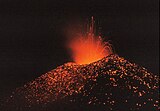Platanar Volcano
| Platanar Volcano | |
|---|---|
 | |
| Highest point | |
| Elevation | 2,183 metres (7,162 ft) |
| Coordinates | 10°18′00″N 84°21′58″W / 10.3000174°N 84.3660879°W[1] |
| Geography | |
| Geology | |
| Rock age | Holocene |
| Mountain type | Volcano |
| Last eruption | Unknown |
Platanar Volcano is located in the Cordillera Central mountain range. It is part of a complex that covers 900 square kilometres (220,000 acres) and is dominated by Porvenir Volcano at 2,267 m (7,438 ft). It is located within the Juan Castro Blanco National Park.
Physical aspects
[edit]It has a destroyed crater to the northwest.[2] Prehistoric lava flows on its western flank;[1] one of them, the so-called Florida flow, was perhaps created by Platanar's most recent activity. Cerro Porvenir has a truncated caldera at the summit with a cone inside.[2] Both of these are part of a composed stratovolcano of Upper Pleistocene age that on Platanar's side overlies the remains of Palmera's collapsed caldera, of probable late Pleistocene age.[3] Platanar has erupted lavas ranging from basalts to andesites in composition.[2]
Social and economic activities
[edit]The western flanks of both volcanoes are used for dairy farming.[4] In 1968 2,500 hectares (6,200 acres) on Cerro Platanar were converted into a National Forest.[5]
Recent activity
[edit]On 30 March 1997 there were six earthquakes on the south flank, the strongest being of magnitude 2.7. A previous seismic swarm in April 1980 had lasted for 2–3 weeks.[6]
References
[edit]- ^ a b "Platanar". Global Volcanism Program. Smithsonian Institution. Retrieved 10 June 2015.
- ^ a b c Guillermo E. Alvarado Induni; Oscar Luis Chavarría-Aguilar, Guillermo E Alvarado Induni (2005). Costa Rica: Land of Volcanoes. EUNED. pp. 144–. ISBN 978-9968-31-366-7.
- ^ Jean Pierre Bergoeing (15 June 2015). Geomorphology of Central America: A Syngenetic Perspective. Elsevier Science. pp. 97–. ISBN 978-0-12-803185-8.
- ^ Hans Otto Spielmann (1969). Viehwirtschaft in Costa Rica: Struktur, Entwicklund und Stellung der Rinderhaltung in einem tropischen Entiwicklungsland (in German). Ludke bei der Uni. p. 210.
- ^ Centro Nacional de Acción Pastoral (Costa Rica) (1990). La Montaña sagrada: una lucha por la vida (in Spanish). Centro Nacional de Acción Pastoral. p. 17.
- ^ "Platanar-Bulletin Report". Global Volcanism Program. Smithsonian Institution. Retrieved 10 June 2015.


